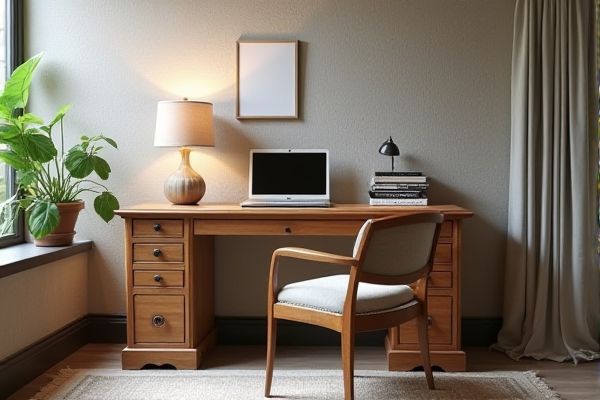
A pedestal desk features sturdy support units or drawers on either side, providing ample storage and a solid workspace, while a writing desk typically has a simpler, minimalist design with a flat surface ideal for note-taking or laptop use. Discover which style best suits Your workspace needs and enhances productivity by reading the rest of the article.
Table of Comparison
| Feature | Pedestal Desk | Writing Desk |
|---|---|---|
| Design | Heavy, large with multiple drawers (pedestals) | Lightweight, simple with flat surface and minimal drawers |
| Storage | High storage capacity with multiple drawers | Limited storage, usually one or two small drawers |
| Size | Bulky and bigger footprint | Compact and space-saving |
| Usage | Ideal for heavy paperwork, office setups | Best for light writing and laptop use |
| Mobility | Low mobility, generally stationary | Easy to move and reposition |
| Cost | Typically more expensive | Generally more affordable |
Introduction to Pedestal Desks and Writing Desks
Pedestal desks feature a spacious work surface supported by two sturdy cabinets or pedestals, offering ample storage with multiple drawers ideal for organizing documents and office supplies. Writing desks prioritize a minimalist design with a flat surface and limited or no storage, promoting a clean workspace suited for tasks like handwriting or laptop use. Both desk types serve distinct functional needs, with pedestal desks excelling in storage capacity and writing desks emphasizing simplicity and openness.
Historical Background and Evolution
Pedestal desks emerged during the Renaissance, characterized by two sturdy columns of drawers supporting a broad writing surface, representing status and functionality in European aristocratic offices. Writing desks date back further, with origins in ancient civilizations where portable, simplistic designs prioritized ease of use and mobility over storage capacity. Understanding the historical evolution of these desks highlights how your workspace preferences can be tailored to combine traditional craftsmanship with modern ergonomic demands.
Key Design Differences
Pedestal desks feature sturdy, built-in support columns on either side, often equipped with multiple drawers for storage, making them ideal for heavy use and organizational needs. Writing desks typically have a minimalist design with slender legs and fewer storage options, prioritizing a lightweight and open workspace. Your choice depends on whether you need extensive storage and durability (pedestal desk) or a sleek surface for writing and light tasks (writing desk).
Materials and Construction
Pedestal desks typically feature robust materials like solid wood, metal, or engineered wood, providing durability through a construction of multiple drawers supported by two sturdy pedestals. Writing desks often prioritize a lighter build, using materials such as lightweight wood, metal frames, or laminates, designed for portability and minimalism. Your choice depends on whether you value the structural strength and storage capacity of a pedestal desk or the sleek, space-saving functionality of a writing desk.
Functionality and Storage Options
Pedestal desks offer superior storage options with multiple drawers and compartments, making them ideal for organizing documents and office supplies efficiently. Writing desks focus more on a minimalist design with limited or no storage, providing a spacious surface primarily for writing or laptop use. Your choice depends on whether you prioritize ample storage or a clean, open workspace for focused tasks.
Space Requirements and Room Placement
Pedestal desks typically demand more floor space due to their larger, bulkier design with multiple drawers or cabinets, making them ideal for spacious offices or rooms with ample layout options. Writing desks feature a more minimalist structure, often with a slim profile and fewer storage components, which suits smaller rooms, tight corners, or minimalist decor schemes. When considering room placement, pedestal desks work best against walls to maximize open space, while writing desks can be placed freely, including against windows or in the center of a room, allowing flexible use in limited areas.
Style and Aesthetic Appeal
Pedestal desks feature a classic, robust design with multiple drawers supported by two sturdy pedestals, offering a traditional and formal aesthetic ideal for vintage or executive office settings. Writing desks prioritize minimalism and elegance with sleek, open surfaces and fewer storage compartments, perfect for modern, minimalist, or artistic spaces. The choice between the two hinges on whether a space demands a commanding, timeless presence or a clean, contemporary look.
Ergonomics and User Comfort
Pedestal desks offer enhanced ergonomics with adjustable height options and ample legroom, supporting better posture for prolonged work sessions. Writing desks, often more compact and minimalistic, prioritize surface space over ergonomic adjustments, which may limit user comfort during extended use. Choosing between the two depends on the need for ergonomic support versus space-saving design in a workspace.
Pros and Cons of Pedestal Desks
Pedestal desks offer substantial storage capacity with multiple drawers, making them ideal for organizing documents and office supplies efficiently. Their sturdy construction provides a durable workspace but can be heavy and difficult to move, limiting flexibility in room arrangement. Limited legroom on one side may reduce comfort for extended use compared to more open designs like writing desks.
Pros and Cons of Writing Desks
Writing desks offer a lightweight, versatile workspace ideal for home offices or small rooms, with their simple design often including minimal storage. They promote good posture and focus but may lack the ample storage space and stability provided by pedestal desks, which feature robust drawers on both sides. The primary advantage of writing desks lies in their portability and sleek appearance, while their limited surface area and fewer compartments can be a drawback for users needing extensive organization.
 homyna.com
homyna.com